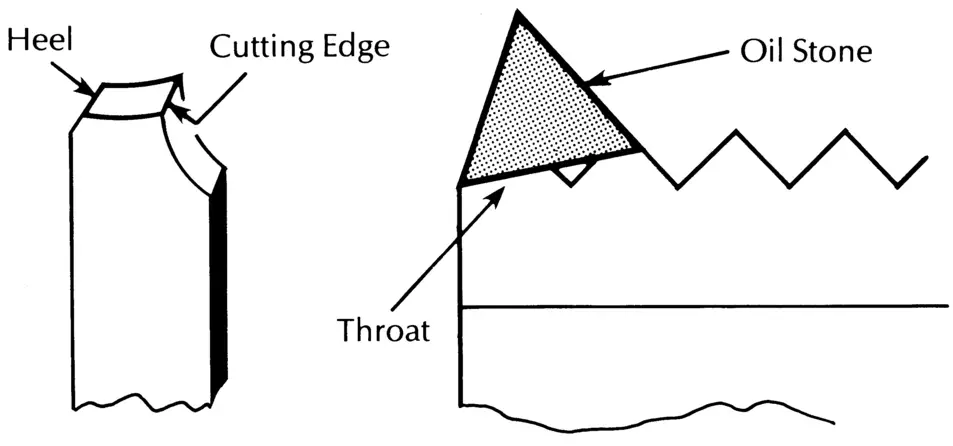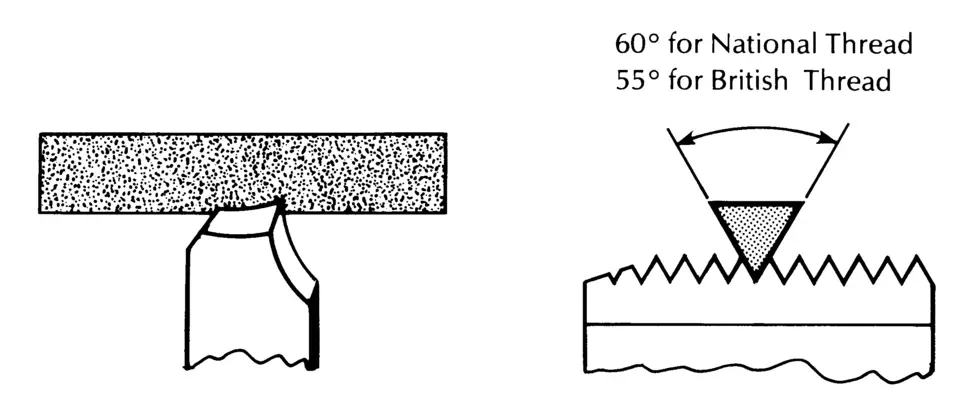Pipe Threading Machine User Guide – Stoning Dies
Stoning Pipe and Bolt Dies to Improve Die Performance
The practice of "stoning" dies, or touching them up with a honing stone, is a way of influencing the forces acting on the die segments. Even the best manufacturing practices and the best controlled sharpening procedures occasionally result in a die which does not operate perfectly on the material required. Carefully adjusting the working surfaces of the die segments is an accepted method of "fine tuning" the operation.
Pipe Dies
Occasionally, new or reground pipe dies may cut a wavy or chattered thread. This may be because the dies do not have enough bearing (see Chaser Operating Theory) or because the throat relief angle is too sharp. Use the following procedure to correct the problem. Use a fine or medium grade three cornered India stone or similar. Use a 60 degree stone for American threads and a 55 degree stone for British standard threads. Use a light honing oil on the stone.
First try stoning the throat of the dies. Place the stone flat against the throat of the die segment with slightly more pressure on the cutting edge than on the heel and pass the stone over the segment throat two or three times. This will effectively reduce the throat clearance angle and will hold the dies more firmly against the scroll in operation. Put the dies back in the die head and try them. if the chatter or wave is not corrected, it will be necessary to stone the teeth as described in the next paragraph.

In stoning the teeth of the die, it is best to let the stone rest in the root of the tooth. Do not push the stone against one flank or the other, but let it ride evenly over both faces. CAUTION. If the teeth are stoned too hard the dies may be ruined or at least need to be reground.
Draw the stone over each tooth lightly two or three times while exerting slightly more pressure on the heel of the die than on the cutting edge. Do not take too much of a cut. Return the dies to the die head and try them. If the problem persists repeat the procedure. It is easy to ruin a set of dies by over stoning, be sure to stone lightly!
Bolt Dies
When cutting bolt threads without a lead screw, and the dies are very sharp, they may have a tendency to cut out of lead. This results in a tooth profile on the threaded part which is misshapen. If the lead flank of the thread is shaved, the dies are said to be operating "too fast". If the receding flank is shaved, the dies are said to be operating "too slow". Bolt dies may also operate fast or slow without shaving. This can be checked by counting the number of threads in one inch of the bolt. If there are too many threads, the dies are operating slow, If there are not enough threads, they are operating fast. (Note! If the dies are operating too fast, the resulting thread is said to be slow, and if the dies are operating slow, the thread is said to be fast.) After the dies have been run several times, a slight "frosting" of the surface of the teeth will be visible. The surface which is frosted is generally adjacent to the edge which needs to be stoned.
DO NOT STONE THE THREADS IN THE THROAT AREA OR THE FIRST FULL TOOTH!
If the dies are running "fast", lightly stone the flank of the tooth on the die which is toward the throat of the die. Place the stone against the flank with slightly more pressure on the cutting edge than at the heel and make two or three passes. If the dies are running "slow", lightly stone the flank of the tooth on the die which is away from the throat of the die. Remove only a small amount of material, and take light cuts.

At Oster Manufacturing, our technical support staff is ready to help with any issue regarding your threading machine. Oster pipe and bolt threading machines are made in the United States with the highest level of quality. These machines are designed to consistently perform at high production rates for decades to come.
Many industries rely on Oster threading machines, from fabrication to agriculture. We rebuild existing pipe threading machines and sell refabricated threading machines for a cost-effective alternative.
Request a quote to learn more about your bolt threading machine options or contact Oster today with any questions.

